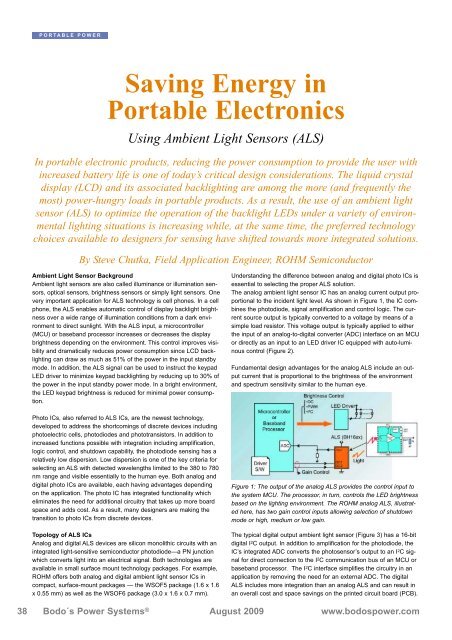Features - Bodo's Power
Features - Bodo's Power
Features - Bodo's Power
You also want an ePaper? Increase the reach of your titles
YUMPU automatically turns print PDFs into web optimized ePapers that Google loves.
PORTABLE POWER<br />
Saving Energy in<br />
Portable Electronics<br />
Ambient Light Sensor Background<br />
Ambient light sensors are also called illuminance or illumination sensors,<br />
optical sensors, brightness sensors or simply light sensors. One<br />
very important application for ALS technology is cell phones. In a cell<br />
phone, the ALS enables automatic control of display backlight brightness<br />
over a wide range of illumination conditions from a dark environment<br />
to direct sunlight. With the ALS input, a microcontroller<br />
(MCU) or baseband processor increases or decreases the display<br />
brightness depending on the environment. This control improves visibility<br />
and dramatically reduces power consumption since LCD backlighting<br />
can draw as much as 51% of the power in the input standby<br />
mode. In addition, the ALS signal can be used to instruct the keypad<br />
LED driver to minimize keypad backlighting by reducing up to 30% of<br />
the power in the input standby power mode. In a bright environment,<br />
the LED keypad brightness is reduced for minimal power consumption.<br />
Photo ICs, also referred to ALS ICs, are the newest technology,<br />
developed to address the shortcomings of discrete devices including<br />
photoelectric cells, photodiodes and phototransistors. In addition to<br />
increased functions possible with integration including amplification,<br />
logic control, and shutdown capability, the photodiode sensing has a<br />
relatively low dispersion. Low dispersion is one of the key criteria for<br />
selecting an ALS with detected wavelengths limited to the 380 to 780<br />
nm range and visible essentially to the human eye. Both analog and<br />
digital photo ICs are available, each having advantages depending<br />
on the application. The photo IC has integrated functionality which<br />
eliminates the need for additional circuitry that takes up more board<br />
space and adds cost. As a result, many designers are making the<br />
transition to photo ICs from discrete devices.<br />
Topology of ALS ICs<br />
Analog and digital ALS devices are silicon monolithic circuits with an<br />
integrated light-sensitive semiconductor photodiode—a PN junction<br />
which converts light into an electrical signal. Both technologies are<br />
available in small surface mount technology packages. For example,<br />
ROHM offers both analog and digital ambient light sensor ICs in<br />
compact, surface-mount packages — the WSOF5 package (1.6 x 1.6<br />
x 0.55 mm) as well as the WSOF6 package (3.0 x 1.6 x 0.7 mm).<br />
Using Ambient Light Sensors (ALS)<br />
In portable electronic products, reducing the power consumption to provide the user with<br />
increased battery life is one of today’s critical design considerations. The liquid crystal<br />
display (LCD) and its associated backlighting are among the more (and frequently the<br />
most) power-hungry loads in portable products. As a result, the use of an ambient light<br />
sensor (ALS) to optimize the operation of the backlight LEDs under a variety of environmental<br />
lighting situations is increasing while, at the same time, the preferred technology<br />
choices available to designers for sensing have shifted towards more integrated solutions.<br />
By Steve Chutka, Field Application Engineer, ROHM Semiconductor<br />
Understanding the difference between analog and digital photo ICs is<br />
essential to selecting the proper ALS solution.<br />
The analog ambient light sensor IC has an analog current output proportional<br />
to the incident light level. As shown in Figure 1, the IC combines<br />
the photodiode, signal amplification and control logic. The current<br />
source output is typically converted to a voltage by means of a<br />
simple load resistor. This voltage output is typically applied to either<br />
the input of an analog-to-digital converter (ADC) interface on an MCU<br />
or directly as an input to an LED driver IC equipped with auto-luminous<br />
control (Figure 2).<br />
Fundamental design advantages for the analog ALS include an output<br />
current that is proportional to the brightness of the environment<br />
and spectrum sensitivity similar to the human eye.<br />
Figure 1: The output of the analog ALS provides the control input to<br />
the system MCU. The processor, in turn, controls the LED brightness<br />
based on the lighting environment. The ROHM analog ALS, illustrated<br />
here, has two gain control inputs allowing selection of shutdown<br />
mode or high, medium or low gain.<br />
The typical digital output ambient light sensor (Figure 3) has a 16-bit<br />
digital I 2 C output. In addition to amplification for the photodiode, the<br />
IC’s integrated ADC converts the photosensor’s output to an I 2 C signal<br />
for direct connection to the I 2 C communication bus of an MCU or<br />
baseband processor. The I 2 C interface simplifies the circuitry in an<br />
application by removing the need for an external ADC. The digital<br />
ALS includes more integration than an analog ALS and can result in<br />
an overall cost and space savings on the printed circuit board (PCB).<br />
38 Bodo´s <strong>Power</strong> Systems ® August 2009 www.bodospower.com







